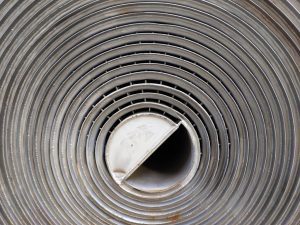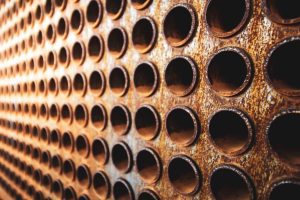The offshore operating environment presents a distinct set of challenges for heat exchanger materials, combining constant exposure to seawater with varying temperatures and significant mechanical stresses from wave and wind action.
Material science stands as a cornerstone in the design, performance, and operational lifespan of heat exchangers across industrial applications. These critical components routinely face extreme operating conditions, including persistent exposure to corrosive substances, continuous thermal cycling, and challenging high-pressure environments. The strategic selection of appropriate materials has become increasingly crucial in minimizing degradation, maintaining operational efficiency, and ensuring system safety throughout the equipment’s lifecycle.
By Omari Hussein Sabuni, Mechanical Engineer, Kinyerezi Power Plant
The impact of material selection extends far beyond immediate operational concerns, directly influencing mechanical and thermal stability while playing a decisive role in extending operational life, reducing maintenance requirements, and enhancing overall energy efficiency. This article explores the intricate challenges associated with material selection, examines the characteristics and applications of commonly used materials, and provides detailed recommendations tailored to specific industrial applications.
Role of material science in heat exchanger longevity
Combating corrosion
Corrosion represents one of the most significant challenges in maintaining heat exchanger integrity, manifesting through various mechanisms that can compromise system performance and safety. Pitting corrosion emerges as a particularly insidious threat, forming localized cavities or “pits” on metal surfaces that progressively weaken structural integrity while remaining difficult to detect in routine inspections. In confined spaces where fluid flow becomes restricted, such as areas beneath gaskets or within deposits, crevice corrosion develops, creating unique challenges for maintenance and prevention.
The phenomenon of stress corrosion cracking (SCC) presents an especially complex challenge, occurring at the intersection of tensile stress exposure and corrosive environmental conditions. This combination can lead to the formation and propagation of cracks that may not be immediately visible but can result in catastrophic failure if left unaddressed. To combat these varied corrosion mechanisms, engineers increasingly turn to advanced material solutions, including the implementation of highly resistant alloys such as Inconel and Hastelloy. These materials offer superior protection against corrosive environments while maintaining structural integrity under demanding operational conditions.
The application of protective coatings, ranging from traditional epoxy systems to cutting-edge nano-coatings, provides an additional defense layer against corrosive attack. Furthermore, the strategic introduction of chemical inhibitors has proven effective in reducing corrosion rates across various operational environments.
Managing thermal stress
The management of thermal stresses represents a critical consideration in heat exchanger design and material selection. These stresses arise from the continuous expansion and contraction of materials as they experience temperature variations during normal operation. Thermal fatigue emerges as a primary concern, developing through repeated temperature fluctuations that force materials through countless cycles of expansion and contraction. This cyclical stress can eventually lead to material weakening and potential system failure if not properly addressed through material selection and design considerations.
The challenge of differential expansion adds another layer of complexity to thermal stress management. When different components within the heat exchanger system expand at varying rates due to temperature changes, significant stress points can develop at interfaces and connections. Addressing these challenges requires a multifaceted approach to material selection and system design. Engineers must carefully choose materials that exhibit high thermal stability while maintaining low coefficients of thermal expansion. The implementation of design features that accommodate thermal expansion without imposing additional mechanical stress has proven crucial in extending equipment life. Additionally, the strategic use of thermal barriers and insulation helps manage temperature gradients effectively, reducing the overall impact of thermal stress on system components.
Mechanical stress and erosion
High-pressure and high-velocity fluid systems present unique challenges related to mechanical stress and erosion. The continuous impact of fluid friction and particulate matter against internal surfaces leads to progressive material wear, potentially compromising system integrity over time. This erosion process becomes particularly concerning in systems handling fluids with suspended solids or in areas where flow velocities exceed design parameters. Mechanical stresses arising from operational pressure fluctuations, installation issues, or external vibrations, can compound these challenges, creating complex wear patterns that require careful material selection and design considerations to address effectively.
To combat these challenges, engineers have developed comprehensive material strategies that focus on both prevention and resistance. The implementation of hardened or surface-treated materials has proven effective in increasing erosion resistance, particularly in high-wear areas. Advanced erosion-resistant coatings provide an additional layer of protection for internal surfaces, while robust design principles help minimize the impact of vibration and mechanical stress points throughout the system.
Comparative analysis of commonly used materials
Carbon steel applications
Carbon steel remains a foundational material in heat exchanger construction, offering a compelling combination of cost-effectiveness and widespread availability. Its high mechanical strength makes it particularly suitable for pressure-bearing applications, providing reliable performance under moderate operating conditions. However, the material’s susceptibility to corrosion, especially in aggressive environments, necessitates careful consideration of protective measures and maintenance requirements. Engineers often implement protective coatings or regular maintenance protocols to extend the service life of carbon steel components, particularly in systems handling non-corrosive fluids or operating under moderate temperature and pressure conditions.

Stainless steel variants
The family of stainless steel alloys, particularly grades 304 and 316, offers exceptional versatility in heat exchanger applications. These materials provide excellent resistance to corrosion across a wide range of operating environments while maintaining good mechanical strength and thermal conductivity characteristics. Their moderate cost position relative to high-performance alloys makes them an attractive option for many applications. However, their susceptibility to stress corrosion cracking in chloride-rich environments requires careful consideration during the selection process. The food processing industry, pharmaceutical production facilities, and chemical plants handling mild corrosive agents frequently utilize stainless steel heat exchangers, benefiting from their balanced performance characteristics and proven reliability.
High-performance alloys
Advanced materials such as Inconel, Hastelloy, and titanium represent the pinnacle of heat exchanger material technology, offering superior corrosion resistance even in highly aggressive chemical environments. These materials maintain exceptional thermal stability and mechanical properties under extreme conditions, making them ideal for demanding applications. However, their implementation often involves significant material and manufacturing costs, along with the need for specialized processing techniques during fabrication. Despite these challenges, high-performance alloys prove indispensable in applications involving high-temperature operations, offshore installations, and environments characterized by aggressive chemicals or constant seawater exposure.
Copper alloy applications
Copper alloys have carved out a significant niche in heat exchanger applications, particularly those involving water-based systems. These materials offer excellent thermal conductivity and inherent resistance to corrosion in aqueous environments, along with beneficial antimicrobial properties that can reduce biological fouling. However, their susceptibility to erosion and stress corrosion cracking, particularly in highly acidic or chlorinated environments, necessitates careful application consideration. Marine environments, HVAC systems, and water-based heat exchange applications frequently utilize copper alloys, taking advantage of their unique property combination while managing their limitations through appropriate design and maintenance practices.
Material recommendations for industry-specific applications

Chemical processing industry considerations
The chemical processing industry presents some of the most challenging operating conditions for heat exchanger materials, requiring careful consideration of material selection to ensure long-term reliability. The presence of aggressive chemicals, combined with high operating temperatures and frequent pressure variations, creates a demanding environment that few materials can withstand effectively. In these applications, Hastelloy has proven exceptional, offering superior corrosion resistance in both oxidizing and reducing environments. Titanium provides another viable option, particularly in systems handling chloride-rich process streams, while Grade 316L stainless steel offers a cost-effective solution for moderately corrosive environments.
Petroleum refinery requirements
Petroleum refineries operate under uniquely challenging conditions that combine high temperatures with corrosive fluids and significant fouling potential. The presence of sulfur compounds, extreme operating temperatures, and abrasive contaminants requires carefully considered material selection strategies. Inconel alloys have demonstrated outstanding performance in these environments, providing excellent resistance to both high-temperature oxidation and carburization. Duplex stainless steel grades offer an attractive balance of strength and corrosion resistance, while properly coated carbon steel can provide economical solutions in less demanding applications within the refinery environment.
Offshore operations challenges
The offshore operating environment presents a distinct set of challenges for heat exchanger materials, combining constant exposure to seawater with varying temperatures and significant mechanical stresses from wave and wind action. Titanium stands out as the premier material choice for these applications, offering unmatched long-term corrosion resistance in seawater environments. Copper-nickel alloys provide a more cost-effective alternative while maintaining good corrosion resistance, particularly in seawater cooling applications. Super duplex stainless steel grades offer another viable option, providing an excellent balance of strength, corrosion resistance, and economic considerations for offshore installations.
Key considerations for material selection
The process of selecting appropriate materials for heat exchanger applications requires careful evaluation of multiple factors that influence both immediate performance and long-term reliability. Corrosion resistance capabilities must be carefully matched to the specific corrosive agents present in the operational environment, often necessitating the use of high-performance alloys or protective coating systems in aggressive settings. The mechanical and thermal properties of selected materials must provide sufficient strength to handle operational pressures while maintaining stability under varying temperature conditions.
Cost considerations play a crucial role in material selection, requiring careful balance between initial investment and long-term performance requirements. This evaluation must consider not only the immediate material costs but also long-term maintenance requirements, potential replacement needs, and the operational impact of potential failures. The compatibility between selected materials and process fluids demands careful attention, often requiring extensive testing and validation to prevent unexpected interactions that could compromise system integrity.
Conclusion
The science of material selection stands as a cornerstone in achieving optimal heat exchanger longevity and performance. Success in this field requires deep understanding of specific industrial environmental challenges combined with comprehensive knowledge of advanced material technologies. Through careful consideration of operating conditions, material properties, and economic factors, engineers can develop heat exchanger systems that deliver enhanced durability, efficiency, and safety while minimizing maintenance requirements and operational downtime.

About the author
Omari Hussein Sabuni is an experienced mechanical engineer at Kinyerezi Gas Power Plant, specializing in heat exchanger design, optimization, troubleshooting and providing practical solutions for various heat exchanger problems. He is skilled in analyzing thermal systems and developing innovative solutions to enhance heat transfer efficiency and adept at conducting feasibility studies, performing risk assessments, and ensuring compliance with industry standards.
About this Featured Story
Why Subscribe?
Featured Stories are regularly shared with our Heat Exchanger World community. Join us and share your own Featured Story on Heat Exchanger World online and in print.


